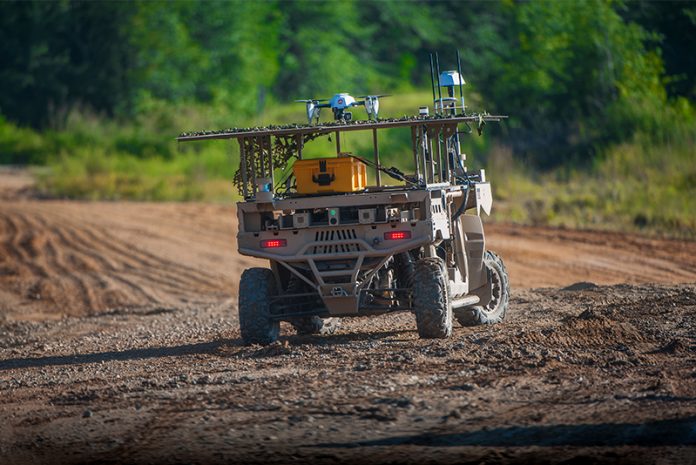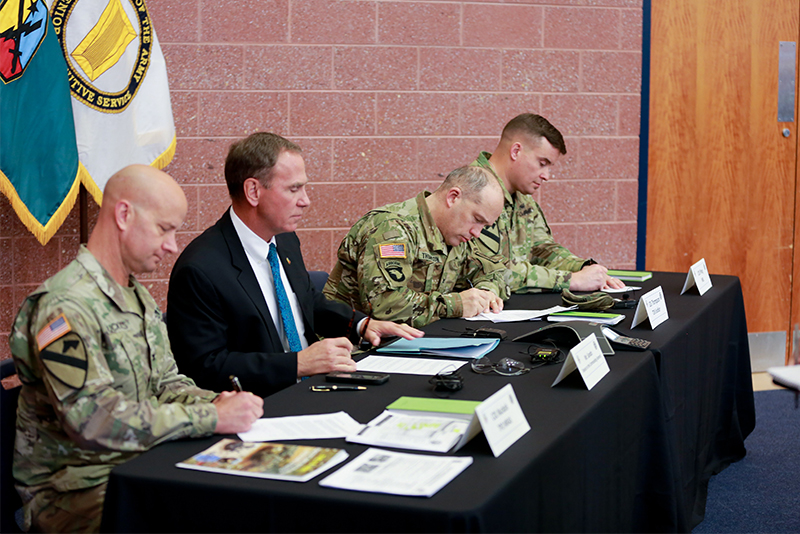
The US Army is conducting robotics programmes to establish how this technology will benefit solders and their capabilities in future operations.
Robotics Programmes
Current robotics programmes being explored by the US Army’s Capability Development Integration Directorate (CDID), part of the Manoeuvre Center of Excellence (MCoE), could well contribute to five areas of Army operational requirements, according the US Army’s Don Sando, deputy to the Commanding General Manoeuvre Center of Excellence and director of CDID, based at Ft. Benning, Georgia.
Speaking exclusively to Armada International, he explained: “These include improving situational awareness, lightening the physical and cognitive soldier load, facilitating battlefield manoeuvre, forward sustainment, and force protection.”
Sando is responsible for developing the concepts and requirements for the US Army under the areas of Soldier Systems, Manoeuvre Systems, and Robotics and Autonomous Systems. He served for 26 years in various positions in the infantry with his last as director of the Infantry Futures Group.
Capability Development Integration Directorate (CDID)
CDID takes its direction and reports to the Army Futures Command which is headed by Gen ‘Mike’ Murray with Lt Gen Eric Wesley as both the deputy Commanding General of Army Futures Command and the director of Futures and Concepts Center.
In his position he is directly influential in defining the performance for both new equipment acquisitions and how these fit into the future force structure. He is specifically focused on the direction, objectives and initiatives being undertaken in the roles, needs, applications and employment of robotic systems in future Army combat and support operations.
Systems falling within this range include individual micro unmanned aerial vehicles (UAVs) like the tiny Black Hornet from FLIR for squad short range reconnaissance, to the Small Multipurpose Equipment Transport (S-MET) for logistics resupply and the Unmanned Combat Vehicles intended to operate in conjunction with manned main battle tanks and infantry fighting vehicles.

Robotic Systems
Sando explained a key consideration in CDID’s effort has been “determining the most suitable unit level at which these robotic systems can be most effectively employed but also where they can be adequately maintained and supported. The question remains as to what is the best way to deploy robotic systems so that ‘they are available when and where needed on the battlefield.”

This is undoubtedly complicated by the increasing presence especially in peer and near-peer conflict of targeted electronic warfare (EW) and cyber assets as became evident in for example the Ukraine. An approach to addressing these threats that has been suggested in experiments would be through applying these technologies at the small unit level and to do so within a more limited area. Doing so offers immediate and direct contribution to tactical capabilities while complicating the ability of EW to effectively target these dispersed units.
“Achieving the optimum return from robotics goes beyond that of a single soldier operating a single unmanned system. This is the case whether the robot is an armed ground combat unit, a logistics resupply vehicle, or an unmanned aerial reconnaissance vehicle. The far greater value would be for the operator to be able to direct multiple robotic systems. To accomplish this Sando said, “requires the application of artificial intelligence (AI) in some form.”
AI Alternatives
The objective is to allow these unmanned systems to be employed in the same manner as current manned systems. CDID is reaching out to industry and academia to identify AI approaches that might be applied to the various robotic scenarios.
Under the 10X Robotic and Artificial Intelligence Dismounted Infantry Platform effort the Army has issued a Request for Prototype Proposals (RfP) which will be considered for selection for demonstration and evaluation in late 2020. Based on previous preliminary submissions somewhere around 30 entries are anticipated in the demonstration. Areas addressed include AI architectures, narrow platform AI, autonomous systems, and communications.

Reflecting on current technologies that have the potential to significantly change the nature of future battle space, Sando suggested that “the capability to share information across the various platforms holds the potential to truly revolutionise combat and the understanding of the battlefield. The autonomous exchange of everything of a rifleman’s sight image to that of an infantry fighting or reconnaissance vehicle or a UAS will all be possible without a deliberate action on their part.”
This might be held in a Tactical Cloud or distributed through a network. “This offers the possibility of achieving a significantly more comprehensive view of the battle area. In doing so it represents a new dynamic in warfare.”
Given that this development information will be increasing “demand based rather than supply based”, each command level will draw on that which is most relevant to their particular need and focus. In fact, one of the upcoming 2020 CDID planned experiments will be examining the possibilities of using the ‘tactical cloud’ by the small unit.
Although robotics and autonomous systems of some variety will clearly have some roles to perform both on the frontline and in support of combat forces, Sando suggested that “exactly where and how these may occur remains to be determined. The objective of our efforts is to both explore the possibilities and access their potential contribution in a manner that allows for sound decisions by Army leadership to achieve the essential dominance in future battles where ever they occur.”












